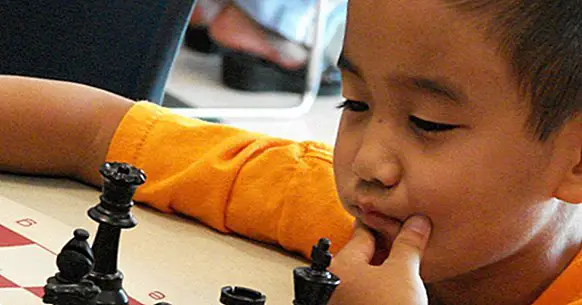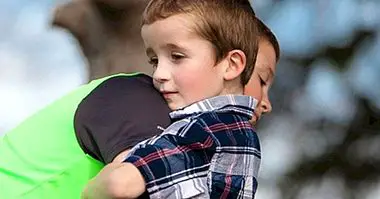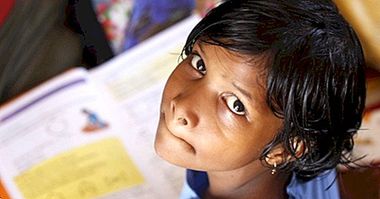The maximum time of concentration of children according to their age
Attention is a fundamental mental capacity for survival by allowing us to attend to the various environmental stimuli. The human being is able to fix it in concrete stimuli during more or less prolonged periods of time, so that it can capture the information pertinent to this stimulation with greater precision and extract the maximum possible data from it.
But the period that we can devote to pay attention to something is not always the same , but it depends on the state of development of the brain. And it is that the different mental faculties are developed and expanded throughout the growth, as it happens with the concentration.
In this article we will see approximately what is the maximum time of concentration of children according to their age , in children up to eight years.
- Related article: "The 6 stages of childhood (physical and psychic development)"
Attention and concentration
Attention is, as we have said, a basic and essential capacity since it makes possible center cognitive resources on external stimulation and activate the organism to act accordingly to it. It is the ability to direct, maintain or shift awareness towards one or a group of stimuli.
There are many aspects that can be explored regarding the concept of attention, since it includes a great variety of different aspects and processes such as alertness and activation capacity or orientation towards stimuli . Among these different aspects we can find concentration.
Concentration is understood as the aspect of attention devoted to keep your attention fixed on a specific stimulus, ignoring the existence of distractors (other possible stimuli that could interfere with the focused element). We are therefore faced with the ability to fix the attention of the individual in a sustained manner.
Concentrating on something allows you to be able to visualize and obtain the maximum possible information regarding the element in question and the application of our voluntary cognitive resources to the service of contemplating, understanding, processing or working on the stimulus in question. Thus, we can study something or stay doing a specific activity for more or less long periods of time.
- Related article: "The 8 superior psychological processes"
Evolution of concentration in the child: maximum times according to age
The ability to concentrate is not something that remains unchanged. There can be different types of elements that make a certain person stay more or less pending a stimulation.
Strong distractions, the existence or absence of motivation, the emotional connection with the stimulus in question or the degree of novelty or routine that supposes are elements to take into account. But apart from that, the maximum capacity of concentration varies throughout life , either by evolutionary development or by environmental or acquired aspects.
In terms of development, to be able to concentrate, it is necessary that our brain has reached an adequate level of maturation. Throughout our childhood the brain continues to grow and develop , allowing little by little that the different cognitive capacities appear and expand. In this way, little by little, the time a child is able to focus attention on something will vary and grow as his brain develops. The ability to concentrate tends to increase between three and five minutes per year of age until its stabilization in adulthood.
Below we indicate an approximate calculation of the time that children up to eight years can maintain concentration. These times establish an interval of average , because each person develops at their own pace and there may be subjects that can have a greater or lesser performance at the time of concentrating.
1. First year of life
It is estimated that during the first year of life the concentration capacity of a baby can be increased little by little until it is maintained between two and five minutes. In this age children they do not stop observing everything and change their focus quickly , unable to concentrate for more than a few minutes.
2. Second year of life
In the second year of life children continue to develop their ability to concentrate, practically doubling the time compared to the previous year. In this way, they can keep it between four and eight or even ten minutes .
3. Third year of life
With three years of life, the ability to concentrate can reach the quarter hour, being common to reach or exceed ten minutes.Up to this age, the concentration is practically maintained while the topic to be treated causes them a real interest, usually losing it in the presence of distracting stimuli. Voluntary attention would begin to emerge and to train after three or four years.
4. Fourth year of life
From that age on, the attention span can increase up to twenty minutes, although even children whose capacity is around eight minutes would enter the average.
5. Fifth year of life
Studies show that during the fifth year of life the concentration can be maintained between ten and twenty-five minutes approximately .
6. Sixth year of life
Concentrating with six years of age is possible, specifically between twelve and thirty minutes due to the greater evolutionary development of the brain.
7. Seventh year of life
Children with seven years of age have a capacity for attention and concentration that is estimated to last on average between twelve to thirty-five minutes .
8. Eighth year of life
With eight years of age, it has been observed that the majority of the population can focus their attention between sixteen and forty minutes of time .
Factors to be considered from the approximate data
The data previously reflected make us see approximately (remember that each child will have their own maturational rhythm, so that the above data is only an average of what would be expected) the attention capacity that infants can have as throughout its development period.
This can serve as a reference when it comes to establish different educational guidelines and not over-demand minors an attention that they may not yet be able to provide because they need more cerebral maturation. In this way, breaks or activity changes can be established that break the attentional focus and lead to another aspect or activity (whether or not it focuses on the same subject).
For example, during a class the teacher can expose a topic and then make them do exercises, so that the attention goes from the exposure to the activity. The ability to concentrate, in this sense, would allow more or less adequate follow-up depending on the age of the subject.
It must be taken into account, however, that the aforementioned times refer to sustained attention or continuous concentration in a single element over time, without factors such as emotion or motivation coming into play. More interactive elements that call your interest as games or movies they can be taken care of more easily and suppose that the children concentrate more and for more time to them. This can also be used to promote learning.
In addition, the concentration can be trained with different types of exercises, but we must try not to overload or overload the children since this can cause that they feel unmotivated, insecure and that diminishes his self-esteem.
Bibliographic references:
- Caraballo, A. (s.f.). The concentration time of children according to their age [Online]. Available at: //www.guiainfantil.com/blog/educacion/aprendizaje/el-tiempo-de-concentracion-de-los-ninos-segun-su-edad/
- Santos, J.L. (2012). Psychopathology. CEDE Preparation Manual PIR, 01. CEDE. Madrid.



















